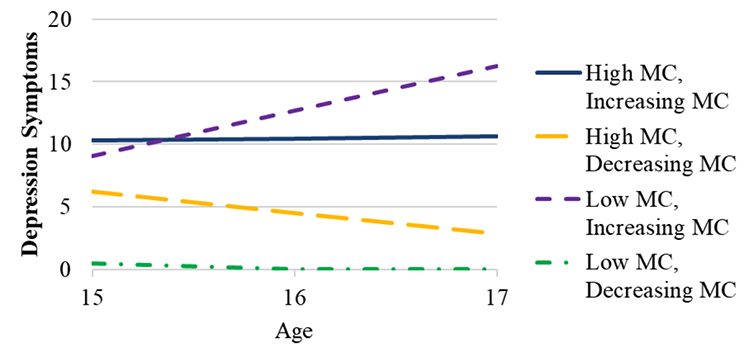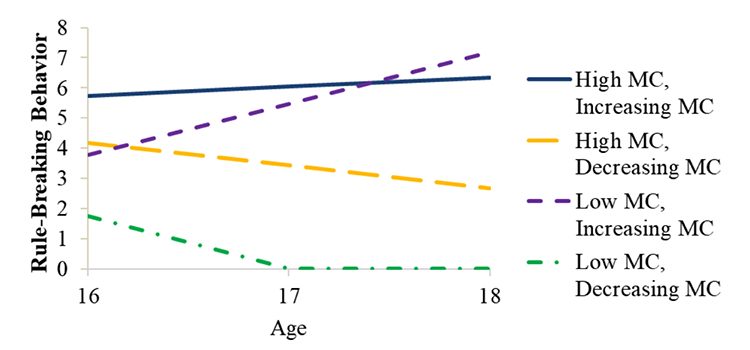Marital relationships evolve over time – even bad ones. As the degree of conflict in the home shifts, how does it affect and predict the mental health outcomes of the children who witness it?
Lauren Philbrook, assistant professor in the Department of Psychological and Brain Sciences, analyzed the subject as one of the co-authors on the paper, “Dynamic Patterns of Marital Conflict: Relations to Trajectories of Adolescent Adjustment,” which was published in the August 2019 issue of Developmental Psychology.
“As a developmental psychologist, I’m interested in how children and adolescents develop into the people they become as adults,” Philbrook says. “I try to understand factors that might mitigate or exacerbate risks for kids as they’re developing across time.”

Marital conflict is a common and well-documented risk factor for many children. Recent studies estimate that 25 percent of 14- to 17-year-old adolescents have witnessed physical assault between their parents, and 41 to 64 percent of adolescents have witnessed verbal or psychological conflict. Children in these settings have a higher risk of both internalizing symptoms, such as anxiety and depression, as well as externalizing symptoms, such as aggression and rule breaking.
Philbrook and her fellow investigators evaluated how those symptoms changed over time in response to changes in marital conflict. Does exposure to marital conflict at an early age have a greater effect on adolescents’ mental health than more recent conflict? What differences emerge in mental health when the level of marital conflict starts out high or low, and then increases or decreases?
Those are a lot of questions to ask of one data set, but the team found a cohort robust enough to provide answers. The Family Stress and Youth Development Study at Auburn University tracked youth across late childhood and adolescence. It collected data at six points during 10 years: at 8, 9, and 10 years of age, and then again at 16, 17, and 18 years old.
“In the prior literature, there’s more work that concentrates on childhood and less on adolescence, and very little that takes repeated measures across time,” Philbrook says.
“This was a unique data set, to have multiple waves of assessment of marital conflict and children’s mental health at both late childhood and late adolescence. Also, the sample was socioeconomically and racially diverse. You want to have a representative sample when you’re trying to understand human behavior, and that’s something this study does well.”
The team’s first analysis of the data revealed a clear result: Proximal, or recent, exposure to marital conflict mattered more for adolescents’ mental health than distal, or past, exposure. “There is definitely a lot of evidence that younger children are very much affected by marital conflict within the home, but for our particular cohort and statistical model there were no distal effects,” Philbrook says. “We’re making the argument that adolescents may be particularly aware of the conflict between their parents, and that sensitivity is problematic for them.”
It was clear that an increasing trajectory of marital conflict was more predictive of negative mental health outcomes than if children started out with high levels that declined.
Philbrook and her fellow investigators then evaluated the data using a slope-intercept model, looking at variations in adolescents’ internalized and externalized symptoms among four combinations: when marital conflict starts high at age 16 and increases over the next two years; starts high and decreases; starts low at age 16 and increases; or starts low and decreases.
“It was clear that an increasing trajectory of marital conflict was more predictive of negative mental health outcomes than if children started out with high levels that declined,” Philbrook says.

Adolescents who experienced high levels of marital conflict at age 16 that increased over time exhibited high and stable levels of depression and rule breaking. Those who were exposed to low levels of marital conflict that increased were more likely to be on trajectories of increasing depression and rule breaking. The outcomes for this low-but-rising group were consistent with other research and support the concept that adolescents are aware of and sensitive to the potential implications of this rising conflict for themselves and their family.
(Interestingly, the models for anxiety and aggression did not provide clear results. Aggression tends to be a stable trait and less susceptible to dynamic changes in environmental risk factors.)
Conversely, a decrease in marital conflict predicted better mental health outcomes. Children who were exposed to a high level of conflict that decreased showed declines in depression and rule breaking. Those who experienced low starting levels of conflict that decreased even further exhibited the lowest and most stable behaviors over time.
“What the results suggest is that intervening to try to reduce conflict in families could have immediate effects for kids,” Philbrook says. “The knowledge that kids are responsive to changes in marital conflict could be used to inform therapy practices.”

Philbrook and her fellow investigators are pondering new directions to take their data. “We’re interested in whether there are physiological changes within the children, such as stress, that we should measure along with these mental health symptoms,” she says. “When there’s declining levels of conflict, are children showing less physiological reactivity, which in turn manifests as fewer symptoms of poor mental health? What is the mechanism of how they’re affected by these increases or decreases in marital conflict? This would be powerful information to show what’s happening within these families.”
Philbrook is also interested in digging deeper into the families whose marital conflict is on the decline. “What are the predictors of that change?” she wonders. “Is it that your kids are getting older and presenting less challenges to the marital relationship? Or is there something the parents are actively doing as a part of their relationship that could be used to help other families? It would be interesting to understand what is leading to the decline and use that to inform interventions for families who are experiencing escalating conflicts.”
El-Sheikh, M., Shimizu, M., Erath, S.A., Philbrook, L.E., & Hinnant, J.B. (2019). Dynamic patterns of marital conflict: Relations to trajectories of adolescent adjustment. Developmental Psychology, 55, 1720-1732. doi: 10.1037/dev0000746
